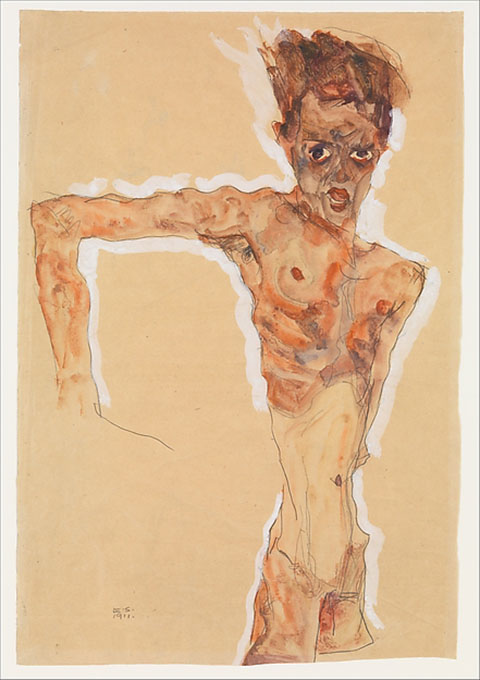Early 20th Century
 Influenced by the work of the Post Impressionists: Van Gogh, Cezanne, and Matisse, there were two great branches of German Expressionism:
Influenced by the work of the Post Impressionists: Van Gogh, Cezanne, and Matisse, there were two great branches of German Expressionism:
¤ Die Brucke: – Ernst Ludwig Kirchner; – Edvard Munch; – Paula Modersohn Becker; – Kathe Kollwitz . . .
¤ Der Blaue Reiter: – Wassily Kandinsky; – Paul Klee; – Franz Marc; – Max Beckman; – Max Pechstein; – Egon Schiele . . .
•→ ARH Presentation German Expressionism⇐
¶ Die Brucke [1906 – 1912]
A group of young architects in Dresden, Germany, formed an alliance and began painting together. They called themselves Die Brucke, which means The Bridge, for they felt that their art would be a bridge to a brighter future, and a way to communicate their utopian ideals to society.
While the Impressionists had worked hard to record exactly what they saw as natural light hit objects in a landscape, the German Expressionists allowed their own personalities to shape their work; to see “the hand of the artist” in a work was something to be encouraged, rather than avoided, they believed. The artists of Die Brucke were interested in extreme psychological states. Munch is perhaps the most obvious example of this (“The Scream”) They were also interested in traditional German folklore and in the tradition of wood block printmaking, which was developed centuries earlier by the German artist Durer.
•→ Edvard Munch – The Scream _ 1893
-The Scream [Munch] used curved shapes and colors that are expressive rather than realistic. Everything is distorted to make you feel a certain way…there is no mistaking the fact that the person in this painting is terrified. The body bends and twists as a scream builds and erupts from deep within. It is a scream so piercing that the figure clasps its hands tightly over its ears. The entire scene vibrates with the intensity of this scream – it echoes across the landscape like ripples across still water (Mittler. Art in Focus. 538).
•→ Ernst Ludwig Kirchner Kirchner painted a series of street scenes in Berlin, the capital of Germany, and the most populous city in Europe before the First World War. It was a city brimming with culture; there were 6 opera companies in the city and over 30 theatres. Dance halls and eating establishments offered non stop entertainment for the bourgeoisie, who loved to dress up and join the parades of fashionable people on the streets.
• One of the themes to which Kathe Kollwitzreturned throughout her career was death. Her husband was a physician in one of the poorest sections of Berlin who offered his services for any price his clientele could afford to pay in cash or goods. Although in many of her prints her characters struggle mightily against death, in her last series of prints, death comes almost as a long-awaited friend, bringing relief from a life whose pain has grown unbearable.
• At the age of 22, Paola Modersohn Becker encountered the artistic community of Worpswede. In this «village», artists had retreated to protest against the domination of the art academy and life in the big city. It was there that she married a fellow Worpswede painter, Otto Modersohn, in 1901… On her last trip to Paris in 1906, she produced a body of paintings which gave her considerable recognition. During this period, she produced her initial nude self portraits (something no woman artist had done before) and portraits of friends such as the poet Rainer Maria Rilke.
÷ ÷ ÷
¶ Der Blaue Reiter ⇐
A second group of German artists formed a group known as Der Blaue Reiter, or The Blue Rider. The name came from a painting by one of the artists in the group: Wassily Kandinsky. These artists were centered in the southern German city of Munich.
¤ Franz Marc painted animals to express his spiritual longing for a return to a more primitive, instinctive, natural mode of living. The science of psychology was new at the time and the work of Freud and Jung had led to a new awareness of man as an animal. Marc believed that human consciousness alienated mankind from the rest of the animal world, leaving humans strangers in the universe.
Marc used colour in a symbolic way. He developed his own colour theory and symbolism, which equated the three primary colours with qualities and emotions. In its simplest terms, Marc associated blue with masculinity, and red and yellow with femininity since they are more earthy colours, but he also associated yellow with joy and happiness. Blue was viewed by Marc throughout his career to be the most deeply spiritual of the three colours.
÷ ÷ ÷
¤ Egon Schiele ↓ [1890-1918]
•→ https://sites.google.com/site/digitaalmuseum/home/schiele-egon ⇐
÷ ÷ ∴ ÷ ÷
¤ Wassily Kandinsky ↓ [1866-1944]
The first artist to cross the line into pure abstraction. The Post Impressionists had begun the movement away from realism. The Fauves took liberties with colour and abandoned the effort to portray space in three dimensions. The German Expressionists were more interested in exploring psychological inner worlds than in faithfully depicting the natural world. Now Kandinsky completely abandoned the necessity of using subject matter that referenced the natural world.
÷ ÷ ÷
¤ Paul Klee
♦ ‘Entartete Kunst’ ↓ ‘Degenerate Art’
This is a documentary from 1993, written, produced, and directed by David Grubin, about the art exhibit under the Nazi regime of what they considered to be the most corrupting and corrosive examples of what they called ‘Entartete Kunst’ or ‘Degenerate Art.’ The exhibit, which opened in July of 1937, was meant to be laughed at and despised. Narrated by David McCullough




Deja un comentario